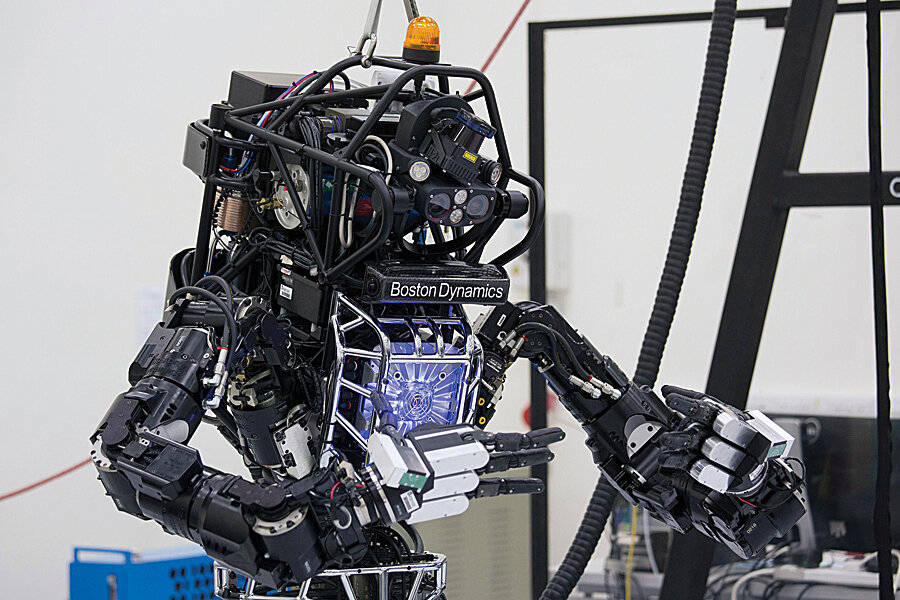Good Reads: From future robots, to crowd-sourcing problems, to praise for kids
Loading...
In the past year, Google has scooped up several humanoid robotics companies, including Boston Dynamics, maker of all-terrain quadrupeds Big Dog and Little Dog; Nest Labs, maker of the smart thermostat and smoke detector; and a wind turbine manufacturer. Add those recent acquisitions to Google’s fleet of self-driving cars and it becomes clear that the search engine has some big ideas for its role in our future, writes Nick Bilton for The New York Times.
“Yet many of its competitors seem to be stuck in the present,” he writes, before adding that Facebook’s, Yahoo’s, and Twitter’s recent acquisitions seem much less ambitious. “It’s unclear where Apple fits into all of this – the company, is, after all, better at keeping secrets than the National Security Agency.... But if Apple is working in secret on its own robot army and futuristic universe, Google is building for the future in public.”
The bottomless pit of poverty
Fifty years after President Lyndon Johnson declared a war on poverty, many of the nation’s poor remain trapped in an endless loop of work, exhaustion, and uncertainty, writes author Barbara Ehrenreich for The Atlantic. “Poverty is not a character failing or a lack of motivation,” she insists. “Poverty is a shortage of money. For most women in poverty, in both good times and bad, the shortage of money arises largely from inadequate wages.”
Ms. Ehrenreich, who wrote “Nickel and Dimed: On (Not) Getting By in America,” tried her hand at several entry-level jobs most readily available to women including hotel housekeeper, server, nursing-home aide, and Wal-Mart associate. She quickly learned that minimum wage did not bring in enough money to pay the bills and the sporadic hours made it nearly impossible to find a second job.
“To be poor – especially with children to support and care for – is a perpetual high-wire act,” she writes.
Crowdsourcing climate change
“If there ever was a problem that’s hard to solve, it’s climate change,” Thomas Malone, Robert Laubacher, and Laur Fisher write for NOVA Next. The challenge is so complex that no one person could ever have the kind of in-depth expertise in atmospheric physics, economics, and human behavior that the task calls for. No problem, write the three researchers from the Massachusetts Institute of Technology’s Center for Collective Intelligence in Cambridge, many heads are better than one anyway.
Enter MIT’s Climate CoLab, an online community where scientists, policymakers, businesspeople, students, economists, concerned citizens – anyone – can submit project ideas for the international community to evaluate. The site is equipped with a computer simulation model that can estimate the potential effects of a particular proposal.
“By bringing together experts, crowds, and key stakeholders, the Climate CoLab opens up the possibility that effective solutions to climate change can come not just from international conferences or labs, but collectively from large numbers of people from all over the world,” they write.
Laboratory for forest restoration
The 400-square-mile Rim Fire that raged for more than a month in the Sierra Nevada last fall caused $54 million in damages and left 60 square miles of completely charred forest in its wake. The state, the US Forest Service, and the National Park Service are left with some difficult choices of how to manage the burned forest, writes Brian Clark Howard for National Geographic.
Should loggers be allowed to haul salvaged wood out of the area or should it be left to rot and replenish the soil? Should the Forest Service conduct controlled burns to reduce the amount of fuel on the ground in the event of another fire? “For some areas of burned forest, the best option may be simply to let nature take its course,” Mr. Howard writes.
Many of the trees that were lost had been planted after a previous fire in the 1980s affected the same area “and may even have contributed to [the Rim Fire’s] ferocity,” he explains. Felled trees, even charred ones, invite beetles, which feed the black-backed woodpecker. Aspens could take advantage of the newly available real estate and sprout up on their own.
In praise of better praise
Parents and teachers touting the merits of positive over negative reinforcement may want to take a closer look at the kind of praise they dish out to children, reports Maria Konnikova for The New Yorker. While there have been numerous psychological studies that suggest that the carrot is a far more effective teaching tool than the stick, sugarcoating that carrot with inflated praise can actually backfire, new research suggests.
In studies conducted by a doctoral student in psychology at Utrecht University, “[c]hildren who were praised emphatically did do better – but only if they had high opinions of themselves to begin with,” Ms. Konnikova reports. Those students then felt empowered to tackle even more difficult tasks. However, kids with low self-esteem who received inflated praise were less likely to take on difficult challenges. Other researchers have found that the same may hold true in the workplace.








